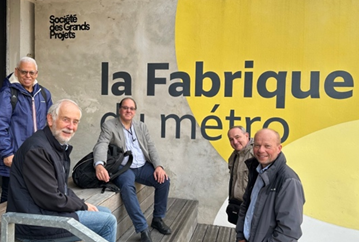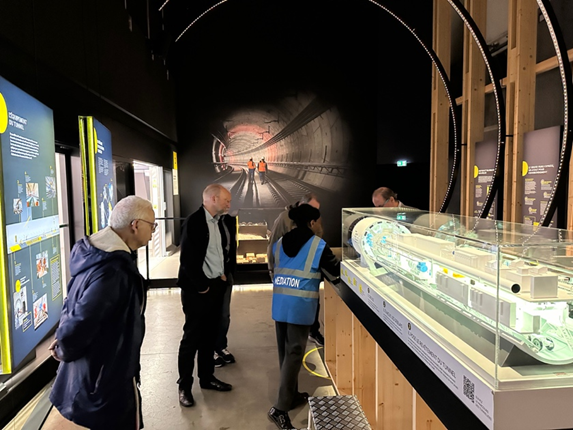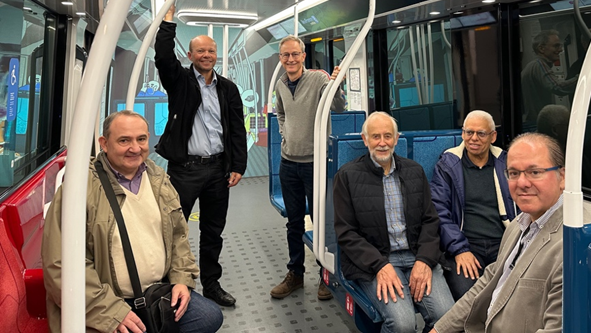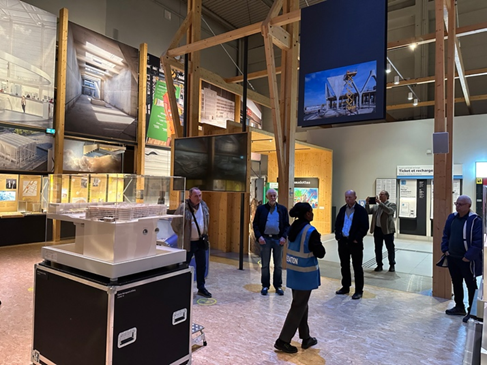Those living in the Paris suburbs are familiar with the ongoing long-term construction of the "Grand Paris Express". Over 40 billion Euros are invested in this mega-project to extend the public transport network around Paris with over 200km of new train lines and 68 new stations. First proposed in its current form in 2009, it's one of the largest projects in Europe. The first stations opened for the Olympics in 2024 and all stations in the current construction phase will open by 2030.
Communication on the project is essential given the significant cost and long-term impact on the local community. The managing company, Societe des Grands Projets, created the "Fabrique du Metro" in Saint-Ouen (northwest Paris suburbs) for this purpose. This is a superb exhibition centre covering all aspects of the project from tunnelling machines, mock-ups of trains, station architecture and much more.

On 8th October 2025, the IET France Local Network arranged a private guided visit of the exhibition in English. This allowed us to experience the venue in a small group and discuss the many engineering aspects. In true French fashion, the visit was postponed from September due to a general strike!

We were met by our guide Lea who started with an introduction of the project along with a description of the four lines, most of which are underground. We moved to the first part of the exhibition covering the exploratory boring that prepared the ground for construction. In some areas, ancient ruins were uncovered requiring archaeologists to investigate. No doubt, the project managers were not pleased with the resulting delays! Next, there were excellent models of the Tunnel Boring Machines (TBM) showing the drilling, spoil extraction and installation of concrete liners. In some areas, the geology requires tunnels up to 52m deep.
The next section covered the trains and stations. The Fabrique du Metro is used as a working laboratory to test the design and operation of all the equipment, hence there is a full-scale construction of a platform including doors, escalators, lifts, seats, screens and even rubbish bins. There were several prototypes installed that were eventually discarded, showing the utility of the facility. It is impressive how well-thought out the ergonomics are, even down to the lighting that changes it hue at nighttime (anti-blue) to avoid disturbing passengers' circadian rhythms. We were able to sit in a mock-up of a train carriage that will eventually be built by Alstom. Each carriage has high capacity thanks to wider carriages yet having backwards compatibility with classic Paris metro lines. This is all made possible due to ergonomic designs of seating and considerably wider carriages (modern construction materials don't take up so much space).

Next, we moved to a section on station architecture. A great deal of thought has been put into making the new stations as attractive and functional as possible. There will be no advertising in the stations to showcase the artwork and landscaping. There is even a new variety of tree that will be planted in every new station.

Finally, we moved to the presentation theatre for some time-lapse videos of the installation and operation of the TBMs.
It was an excellent visit lasting 1.5 hours offering a new perspective on the project with the design, planning and the methods of construction. After the visit, most of the group stayed on for networking between the local members, guests and a member from the Barcelona Local Network.
The Fabrique du Metro is well worth visiting if you are in the Paris area, although the public visits are in French. The web site is https://www.grandparisexpress.fr/fabrique-du-metro/visiter